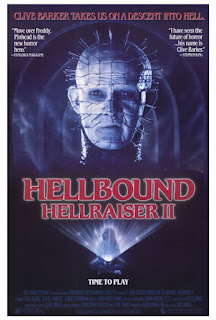Hello and welcome back to the Third Row as we continue this October’s franchise dive into the weird, winding world of Clive Barker’s Hellraiser.
At this point, I have to give a proviso - in the past, I’ve tried to do the write ups with each viewing to take them on their own terms. For the amount of material for this, I’m now into the back half of the films viewing-wise. Expect the writing to step up from here.
That wasn’t why I brought this up. The reason I brought that up here is because this month is the first time it ever really hit me just how quickly this property got up and running as a franchise.
To put this on a timeline: The Hellbound Heart was published in November of 1986. The adaptation went into production by the end of the year, being released in September of 1987. The film went on to box office success and a sequel was soon underway, seeing its way to wide release in December of 1988.
Pretty surprising how quickly a story this heavily leaning into S&M and the occult took off.
As it's another aspect I will be tracking this month, I have to note Clive Barker did not return to the director's chair for this movie, passing the reins to first time director Tony Randel. Barker is still actively involved, however, helping develop the story with Peter Atkins (who becomes another recurring influence on this series.)
That Barker still has as much of a hand in this entry as he does is reflected in how it fits the larger arc of these movies. As with the first film, the Cenobites are prominently marketed, but they aren't meant to be the movie's primary antagonists.
Once again, the driving force at the heart of this movie is more human monsters. In this case, Claire Higgins returns as Julia, though this time she is now the corrupter instead of the corrupted. Her counterpart, in turn, is the movie’s new antagonist, Dr. Channard (Kenneth Cranham.)
The dynamic between Julia and Channard is an interesting counterpart to the first movie, offering parallels without feeling like rote repetition. Julia isn’t an escapee from Hell - she is acting as an agent of Leviathan, leading Channard into Hell rather than away from it. Channard, meanwhile, seeks out Hell not for pleasure as Frank did, but out of a desire for knowledge. Where Frank was a jaded hedonist, Channard is more of a Faustian antagonist, spurred into the Labyrinth by his desire to learn more of life beyond death.
By comparison, the Cenobites are not the main threat of the movie. In the larger story of the film, they actually matter very little this time. They largely exist to serve as part of Kirsty’s connection to the story. For his part, Pinhead gets a backstory, and it’s nice to see Doug Bradley instill humanity into his iconic character, but it’s secondary to the larger story.
Where the Cenobites and humans collide is where I found myself torn on this watch. On one side, I find the ideas it presents - Leviathan upsetting the order of Hell through Channard and coming against the old guard of the Cenobites - is an interesting idea. I like that, once again, it frames the Cenobites not as heroes or villains, but more the enforcers of a darker cosmic order. At the same time, I find the idea the movie posits about the origin of Cenobites - humans who, for reasons that are never explained, are chosen to serve as Hell’s priests rather than simply be vivisected for all eternity, adds a concept that over-complicates the larger story. Especially since it’s something that is never explained in this or other entries in terms of why someone is made a Cenobite while someone else is simply tortured.
Even with that muddying of the waters, however, I still enjoy Hellbound as a sequel. It takes some interesting swings - going from the fairly low key, low stakes setting of the first and expanding it to the level of a literal descent into Hell itself - and even if it raises some questions that are never answered, it's still a satisfying ride from start to finish.
Speaking of which, the movie’s depiction of Hell is practically a character unto itself - between the expansive tableau of the Labyrinth (and some good use of matte paintings), the very stylized visions of each person’s individual damnation, and the cosmic horror aspects of Leviathan, a being represented in vague concepts - Barker and Randel make a fascinating break from the traditional fire and brimstone vision of Hell that adds a level of engagement to the movie.
It's only tangential, but I do want to give a shout-out to
Christopher Young for his score on the first two movies.
His music really adds to the dark, fantastical element of these
films that subsequent films never quite manage to capture again.
Part of me would have loved to see this as the path the series would go down - continuing to explore the strange mythology of this Hell that the Cenobites represented just a small part of (and, for his part, Barker had his own vision we’ll touch on next time.)
Unfortunately, these visions didn’t come to pass. Where this movie went big, the next movie dials things back.
That said, this still doesn’t rob from the fact that this makes for a fascinating, if sometimes muddled, expansion on the original movie. As the next step on the road to a larger franchise, Hellbound is an ambitious movie that broadens the scope of the first and leaves a taste for that larger cosmology that, I’ll just say now, will go unfulfilled in later movies.
But, that is a discussion for later.
Keep an eye out as we return to the series soon, and to much lower stakes, with Hellraiser III: Hell on Earth.




No comments:
Post a Comment